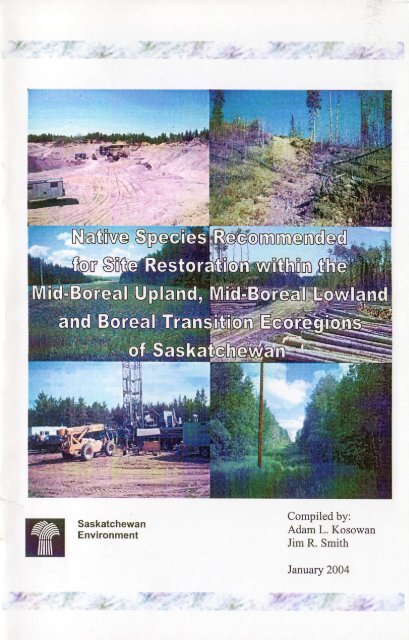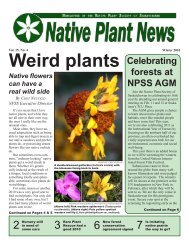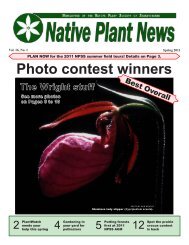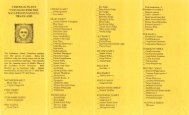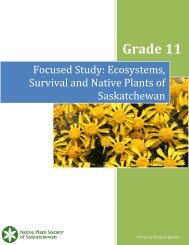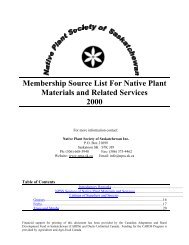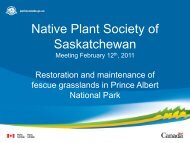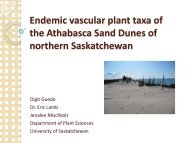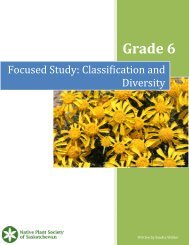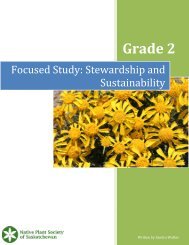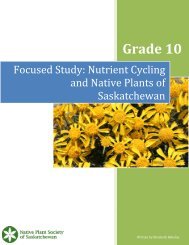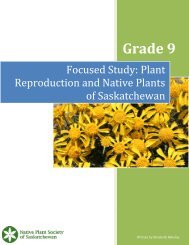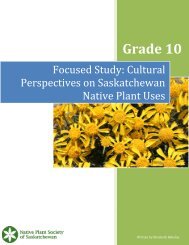Native Species Recommended for the Forest Ecoregions of ...
Native Species Recommended for the Forest Ecoregions of ...
Native Species Recommended for the Forest Ecoregions of ...
- No tags were found...
Create successful ePaper yourself
Turn your PDF publications into a flip-book with our unique Google optimized e-Paper software.
DEDICATIONThis publication is dedicated to <strong>the</strong> memory <strong>of</strong> Wayne Harris, who hagicallypassed away on October 7,2002.As an employee <strong>of</strong> <strong>the</strong> Department <strong>of</strong> Environment <strong>for</strong> 13 years, Wayne was aspecial person with breadth and depth in a variety <strong>of</strong> resource disciplines. Hehad a passion <strong>for</strong> raptors, and banding young Femrginous and Swainson'shawks became part <strong>of</strong> his job. He went <strong>the</strong> extra mile to obtain in<strong>for</strong>mation onendangered species, putting in long and grueling field days followed by earlymorning and late night hours in <strong>the</strong> <strong>of</strong>fice, documenting in<strong>for</strong>mation andnetworking with o<strong>the</strong>rs to advance <strong>the</strong> protection <strong>of</strong> Saskatchewan'sbiodiversity. Wayne co-operated with <strong>the</strong> oil and gas industry to determinemethods, which allowed <strong>for</strong> development, while minimizing impacts on <strong>the</strong>wildlife resource, particularly native vegetation. He recognized <strong>the</strong> importance<strong>of</strong> reducing <strong>the</strong> impacts <strong>of</strong> exotic species, to <strong>the</strong> extent that he made a personalef<strong>for</strong>t to remove Japanese brome from pastures in <strong>the</strong> southwest corner <strong>of</strong> <strong>the</strong>province.As a respected and prominent ecologist, Wayne authored and co-authorednumerous publications within and outside government. Some <strong>of</strong> his writtenwork includes a pioneer ef<strong>for</strong>t in preparing a description <strong>of</strong> understoryvegetation within various <strong>for</strong>est ecosystems.His dedicated and pr<strong>of</strong>essional ethic is acknowledged. His caring <strong>for</strong> <strong>the</strong>environment and contributions <strong>of</strong> time and knowledge remain a legacy.
TABLE OF CONTENTSAcknowledgements......... .........................1Introduction. ........................2Site Definitions.................<strong>Species</strong> by Site Type - Grasses, Sedges and Rushes.......'.....'.......'....5<strong>Species</strong> by Site Type - Forbs ........... ............................' 8<strong>Species</strong> by Site Type - Shrubs .....'.'.........1IIn<strong>for</strong>mdtion Sources ........FIGURESMid-Boreal Upland, Mid-Boreal Lowland and Boreal Transition <strong>Ecoregions</strong>in Saskatchewan................................'......3
ACKNOWLEDGEMENTSThis report is a collaborative ef<strong>for</strong>t between government and non-governmentparticipants. It has been prepared as a practical guide to assist in <strong>the</strong> use <strong>of</strong>native species <strong>for</strong> rehabilitating disturbed areas. Saskatchewan Environmentstaff leading preparation <strong>of</strong> <strong>the</strong> report includes: Adam Kosowan, Jim R.Smith, Rob Wright, Ann Gerry, Sheila Lamont and Bob Wilson.Thanks are extended to Dr. Jim Romo, Pr<strong>of</strong>essor, University <strong>of</strong> Saskatchewanand <strong>the</strong> students from <strong>the</strong> Landscape Ecology and Vegetation ManagementClass, John Conkin, Sherry Stewart, Jennifer Femet, Andrew Pantel, NeilBlock, Tara Sample, Debbie Borowsky and Tim L'Arrivee. The student papersprovided a basis <strong>for</strong> this report.The project was fur<strong>the</strong>r advanced by Joel Ulmer, a summer student withSaskatchewan Environment, who syn<strong>the</strong>sized <strong>the</strong> student reports. The workundertaken by Joel is appreciated.The assistance provided by Dr. Vernon Harms, Pr<strong>of</strong>essor emeritus, University<strong>of</strong> Saskatchewan and John H. Hudson, Botanist, with reviewing <strong>the</strong> report isgratefully acknowledged.Thanks are also extended to Ron Erickson, Director, and Chris Dunn,Integrated Resource Manager, Prince Albert, <strong>for</strong> <strong>the</strong>ir adminishative support,and to numerous o<strong>the</strong>r Saskatchewan Environment colleasues <strong>for</strong> <strong>the</strong>ircontributions.
INTRODUCTIONThe maintenance <strong>of</strong> ecological structure, function and composition requires anunderstanding <strong>of</strong>natural ecosystems, and <strong>the</strong> corresponding application <strong>of</strong>thatknowledge. Humans are unable to replicate pre-disturbance natural processes,but are able to minimize <strong>the</strong> impacts <strong>of</strong> man-made disturbances on <strong>the</strong>landscape and facilitate recovery toward a natural system.Exotic species are recognized as a threat to <strong>the</strong> maintenance <strong>of</strong>naturalbiodiversity. Studies by Saskatchewan Environment have demonstrated thatsoil exposure provides a favorable location <strong>for</strong> <strong>the</strong> establishment <strong>of</strong>undesirable plant species. Early re-establishment <strong>of</strong> native species on disturbedsites is recommended <strong>for</strong> mitigation. The intent <strong>of</strong> this report is to serve as apractical guide <strong>for</strong> <strong>the</strong> selection <strong>of</strong>suitable native species to reclaimdisturbances within <strong>the</strong> Mid-Boreal Upland, Mid-Boreal Lowland and BorealTransition <strong>Ecoregions</strong> (Figure l).As disturbances generally result in habitats exposed to sunlight, <strong>the</strong> specieslisted are suitable <strong>for</strong> sunlight conditions. They are organized within <strong>the</strong>following site categories: dry, fresh, moist, wet and organic. Proportionally, itis suggested that <strong>the</strong> dry, fresh and moist site species mixes contain 80 to 90%grasses (and grass-like) and 10 to20Yo <strong>for</strong>bs. The wet and organic site speciesshould contain approximately 95% grasses (and grass-like) and <strong>the</strong> balance<strong>for</strong>bs. Four or more grass (and grassJike) species and four or more <strong>for</strong>bspecies should be used in <strong>the</strong> mix. To confirm proper species selection andlocate rare species, proponents are encouraged to undertake vegetation surveysprior to development.The species listings are based on ecological suitability without consideration toseed procurement (purchase or collection). It is suggested that users obtainadditional in<strong>for</strong>mation on species characteristics prior to purchasing seed andplanting. Local origin seed with purity from weeds is recommended.Additional in<strong>for</strong>mation sources are identified in this report.The authors believe that this report is a useful starting point and encouragefuture ef<strong>for</strong>ts toward a better understanding <strong>of</strong> site and species relationships.
Figure 1. Mid-Boreal Upland, Mid-Boreal Lowland and Boreal Transition<strong>Ecoregions</strong> in Saskatchewan.
SITE DEFINITIONSDry: Moisture and nutrient deficient sites, commonly supporting jack pine<strong>for</strong>ests (rapidly drained sands). Examples include <strong>the</strong> Nisbet and Fort-dla-ComeProvincial <strong>Forest</strong>s. These are <strong>the</strong> driest sites supporting <strong>for</strong>estgrowth.Fresh: These sites are commonly differentiated from <strong>the</strong> dry category by <strong>the</strong>presence <strong>of</strong>clay or silt in <strong>the</strong> soil pr<strong>of</strong>ile. They are topographicallylocated from <strong>the</strong> mid to upper slope positions. Coarse soils (sands) mayalso occur in this site category; however, <strong>the</strong>y are topographicallylocated on lower slopes where groundwater or run<strong>of</strong>f influencesvegetation growth. A variety <strong>of</strong> boreal tree species may be found on<strong>the</strong>se sites <strong>of</strong> average growing conditions.Moist: Soils within this site category may be a variety <strong>of</strong> textures (sands,clays etc). Due to topography (mid-slope to depression), landscape(productive lowland) or o<strong>the</strong>r influence, more water is available <strong>for</strong> plantgrowth than in <strong>the</strong> previous categories. These are <strong>the</strong> most productive<strong>for</strong>est sites on which a variety <strong>of</strong> boreal <strong>for</strong>est species may be found.Wet: These sites are seasonally saturated or located in areas with a higherwater table. The soils may be a variety <strong>of</strong> textures (sands, clays etc.) andare usually overlain by a shallow layer <strong>of</strong>peat. These poorly drainedsites are usually occupied by black spmce, white spruce and tamarack ormay consist <strong>of</strong> meadows located in depressions.Organic: Prolonged saturation and organic matter accumulation (> 40 cm) arecharacteristic <strong>of</strong> <strong>the</strong>se sites. They are located in areas with a high watertable and commonly termed bogs and fens. The bogs may contain ablack spruce and/or tamarack <strong>for</strong>est cover; whereas, <strong>the</strong> dominantvegetation <strong>of</strong>fens are grasses and grass-like species.
SPECIES BY SITE TYPE - GRASSES. SEDGES AND RUSIIES'DRYFREsHSITEMoIsTwEToRGANICalpine rush(Juncus alpinus; Juncus alpinoarticulatus ssp. nodulosus2 )awned sedge(Carex a<strong>the</strong>rodes)awned wheat grass(Agropyron subs ecundum ; Elymus trachycaalas ssp. subsecundus)beaked sedge(Carex utriculata)bog muhly( Muhl enbe r sia clo m er at a )rog sedge/Carex masellanica),ommon cattaillTvnha latifolia)lommon great bulrush/Scirpus lacustris ssp, validus ; Schoenoplectus tabernaemontanus)common reed grass(Phragmites communis; Phragmites australis )common sweet grass(Hierochloe odorata):reeping spike-rush'Eleocharis oalustris )Dudley's rushUuncus dudlevi)fowl bluegrass(Poa palustris)fowl manna grass(Glycerid striata)foxtail barley(Hordeum iubatum)fringed brome(Bromus ciliatus)great bulrush(Scirpus lacustris ssp. acutus; Schoenoplectus acutus var. acutus)' Suitable species within each site type.I Sfu.t shading identifies species <strong>for</strong> primary consideration. O<strong>the</strong>rs may be suitable.I C.uy shadinfidentifies species <strong>for</strong> secondary consideration. O<strong>the</strong>rs may be suitable.It is recommended that users fur<strong>the</strong>r veriff species/site suitability as soil characteristics such asacidity and salinity can influence species selection and survival. In addition, some species listedwithin <strong>the</strong> "organic" category are found in shallow water.2 The first Latin name has until recently been <strong>the</strong> accepted name and appears in books onvascular plants. The second is <strong>the</strong> cunently accepted name available only in new or revised flora.
SPECIES BY SITE TYPE - GRASSES, SEDGES AND RUSHESDRYSITEF M wR o EE I TS sTHhairJike sedge(Carex caoillaris) :1.1:.:,rairy wild ryelElymus innovatus ; Leymus innovatus)inland blue grass(Poa interior; Poa nemoralis ssp. interior)June grass(Koeleria macrantha)knotted rush(Juncus nodosus)malsh reed gfass(C alamagro s tis cana d e nsi s )narTow reed gfass(Calamagrostis neglecta ; C alamagrostis stricta ssp. stricta)nodding brome(Bromus anomalus; Bromus Porteri)nor<strong>the</strong>m brome(Bromus oumoellianus: Bromus inermis ssp. pumpellianus)ror<strong>the</strong>m manna grasslGlyceria borealis)nor<strong>the</strong>m reed grass(Calamasrostis inexDansa : Calamagrostis strictd ssp- inexpansa)nor<strong>the</strong>m rice grass(Orvzoosis punsens : Pipta<strong>the</strong>rum pungens)plains rough fescue(Festuca altaica ssp. hallii))urple oat glass/ Schizachne purpur as ce n s )rocky mountain fescue(Festuca saximontana)ough hair grass'Asrostis scabra)usset cotton-grass/ Eriophorum chamis o ni s )shea<strong>the</strong>d cotton-grass(Erioohorum vasinatum ! at. vaginatum)shea<strong>the</strong>d sedge(Carex vasinata)i ,,: ,,' _.;,:1.1ill$s&W,..jdfioRGANIc:.''1
SPECIES BY SITE TYPE _ GRASSES. SEDGES AND RUSHESilender cotton-grass'Eriophorum gracile)rlenderush'Juncus tenuis);and sedge'Caret houghtoniana);ilvery-flowered sedge'Carex aenea; Csrex siccata)ilender wheat grass'Agropyron trachycaulum; Elymus trachycaulus ssp. trachvcaulus)ilough grass' B e c kmannia svzi sac hne );mall-fruited bulrush/Scirpusmicrocarpus)itreambank wheatgrass'Apropyron riparium: Elvmus lanceolatus var. rioarius);all cotton-grass/ E rio p ho rum anws tifo lium )DRYFREsHSITEMoIsTwEToRGANIctall manna grass(Glyceria grandis)timber oat grass( D ant h onia int erme di a):hinJeaved cotton grass'Erio p h o rum v ir idicar inatum):ufted hair grass' D e s c hamp s ia cae s p ito s a):wo-stamened sedge'Carex diandra)water sedge(Carex aquatilis)white-grained mountain rice grass(Ory zo p s is as per ifo lia )wire rush(Juncus balticus)yellow bog sedge'Carex gtnqcrates)
American dragonhead(Dr acoceohalum p amifl orum )American vetch(Vicia americana)SPECIES BY SITE TYPE _ FORBSarrow-leaved coltsfoot(Petasites sagittatus ; Petasites frigidus var. sagittatus)arumleaved arrowhead(Sagittaria cuneata)balsam groundsel(Senecio pauperculus ; Packera paupercula)Bicknell's geranium(Geranium bicfuellii)rlue columbine/ A a uile sia b rev is tv I a )broad-leaved pussytoes(Antennaria neglecta)bristly buttercup(Ranunculus p ensy Iv anicus)ruck-bean/M env an<strong>the</strong>s trifo li at a)runchberry/Cornus canadensis)3anada anemonelAnemone canadensis)DRFRFsH3anada goldenrod(Solidaso canadensis)common harebell(C amnanu I a ro tundifo li a ) lcommon yarrow( A c hil I e a m i I I efo I iu m)cow-parsmp(Heracleum lanatum ; Heracleum maximum)cream-colored vetchling(Lathyrus ochroleucus)cut-leaved anemone(Anemone multifida)cutJeaved ragwort(Senecio eremophilus)Ii:;:lSITEMoIsTi}r);r$sll:::',early blue violet#;r(Viola adunca) 4fireweed(Eoilobium ansustifolium : Chamerion ansustifolium)lranklin's scorpionweed'Phacelia franklinii)IwEToRGANICllt;:fr':''trs i.':"r-
SPECIES BY SITE TYPE _ FORBSDRYFRESHSITEMoISTwEToRGAN Icliant hyssop'A s as t ac h e fo e ni culum )golden dock/Rumex maritimus)lapland buttercup(Ranunculus lapponicus)Lindley's aster(Aster ciliolatus ; Symphyotrichum ciliolatum)long-leaved starwort( S t e I I ar i a I o n gifo I i a)long-stalked chickweed(Stellaria longipes)Macoun's buttercup(Ranunculus macounii)marsh aster(Aster borealis ; Symphyotrichum boreale)marsh hedge-nettle(Stachys palustris var. pilosa; Stachys pilosa)marsh ragwort(Senecio congestus)marsh skullcap(Scute I laria eale riculata)nountain goldenrod'Solidago spathulata; Solidago simplex ssp. simplex)narrow-leaved dock(Rumex salicifulius v ar. mexicanus)narrow-leaved hawkweed(Hieracium umbellatum)nor<strong>the</strong>m bedstraw(Galium boreale)nor<strong>the</strong>m daisy fleabane(Erigeron acris)nor<strong>the</strong>m gentian(G entianella amarella ssp acuta)nor<strong>the</strong>m valerian(Valeriana dioica var. sylvatica)palmate-leaved coltsfoot(Petasites palmatus; Petasites frigidus var. palmatus))hiladelphia fleabane'Erigeron philadelphicus )rlains wormwood'Artemisia campestris )lrarne crocus'Anemone patens; Pulsatilla patens ssp. multiJida)purple peavine(Lathyrus venosus)Idlffi9
SPBCIES BY SITE TYPE _ FORBSans er ina ; A rge ntina dnse rina)s te IIata ; Maianlhemum s tel latum)Isaved false solomon's-scalveiny meadow rueWestem Canada violet'Rumex occidentalis; Rumex aquaticus vat(As le r hes pe r ius ; Sy mphyo tr ic h um lanceo la tu mwild lily-<strong>of</strong>+he-valley(Maian<strong>the</strong>mum canaclensewild rnint(Mentha arvensiswoodland strawbenyow rnarsh-marigoldltha nalustris)l0
SPECIES BY SITE TYPE _ SHRUBSalderleaved buckthom(Rhamnus alnifolia)reaked hazelnut'Corylus cornuta)rearberrylAr c t o s t ap hy I o s uva -ut" s i )bog birch(Betula glandulosa; Betula nana)Canada blueberry(Vaccinium myrt illoides)bracted honeysuckle(Lonicera involucrata)Canada buffaloberry(Shepherdia canadensis)chokecherry(Prunus virginiana var. melanocarpa)common Junrper(Juniperus communis)lommon snowberry/Symphoricarpos albus);reeping juniper/Ju n i p eru s h ori z o n t a I i,s )dry-ground cranberry( Va c c in ium I i ti s - ida e a)dwarfbirch(Betula pumila var. glandulifera)dwarf bog-rosemary(Andromeda polifolia)fly honeysuckle(Lonicera villosa)green alder'Alnus crispa: Alnus viridis sso. crispa)righ bush-cranbeny'Viburnum trilobum : Yiburnum ooulus )DRYFRESH,i;,$llwj::n€ii{:fi-r'li.;::=r{i:.::i:'iSITEMoIsTwEToRGANIC11
SPECIES BY SITE TYPE _ SHRUBSLabrador tea(Ledum sroenlandicum)lea<strong>the</strong>rleaf(C hamae daphne c aly cul ata)low bush-cranberry(Viburnum edule)nor<strong>the</strong>m bog-laurel(Kalmia polifolia)pin cherry(Prunus pensylvanica)DRYFRESHt""*.SITEMoISTrrickly rose'Rosa acicularis):ed-osier dogwood/Cornus stolonifera: Cornus sericea sso. stolonifer) ,river alder(Alnus tenuifolia; Alnus incana ssp. tenuifolia)SaskatoonrA m e I anc h ie r a I n ifo I ia)shrubby cinquefoil(Potentilla fruticosa: DasiDhora fruticosa ssp. floribunda)small bog cranberryr'Orycoccus micrcarpus ; Vaccinium orycoccos)twining honeysuckle(Lonicera dioica)wild gooseberry(Ribes oxv acanthoides )wild red raspberry(Rubus idaeus ssD. str,.sosrrs)willows(Salix soo.)liiawETir,.:,1.'oRGANICt2
INFORMATION SOURCESActon, D. F., G.A. Padbury and C.T. Stushn<strong>of</strong>f (Principal Authors) and L.Gallagher, D. Gauthier, L. Kelly, T. Radenbaugh and J. Thorpe(Contributing Authors). 1998. The <strong>Ecoregions</strong> <strong>of</strong> Saskatchewan.Saskatchewan Environment and Resource Management and CanadianPlains Research Center, University <strong>of</strong> Regina. 205 pp.Gerling, S. G., M. G. Willoughby, A. Schoepf, K. E. Tannas and C. A. Tannas'1996. A Guide to Using <strong>Native</strong> Plants on Disturbed Lands. AlbertaAgriculture, Food and Rural Development and Alberta EnvironmentalProtection. ISBN 0-7732 -6125-7.247 pp.Hardy BBT Limited. 1989. Manual <strong>of</strong> Plant <strong>Species</strong> Suitability <strong>for</strong>Reclamation in Alberta - 2no Edition. Alberta Land Conservation andReclamation Council Report No. RRTAC 89 -4. 436 pp.Harris, W.C. Revised 1989. A Guide to <strong>Forest</strong> Understory Vegetation inSaskatchewan. Govetnment <strong>of</strong> Saskatchewan and <strong>Forest</strong>ry Canada.106 pp.Johnson, D., L. Kershaw, A. MacKinnon and J. Pojar. 1995. Plants <strong>of</strong> <strong>the</strong>Western Boreal <strong>Forest</strong> and Aspen Parkland. Lone Pine Publishingand <strong>the</strong> Canadian <strong>Forest</strong>ry Service. ISBN l-55105-058-7. 392pp.Kabzems, A., A.L. Kosowan and W.C. Harris. 1986. Mixedwood Section inan Ecological Perspective Saskatchewan. Technical Bulletin No. 8,Second Edition. Saskatchewan Parks and Renewable Resources andCanadian <strong>Forest</strong>ry Service. 122 PP.<strong>Native</strong> Plant Society <strong>of</strong> Saskatchewan. info@,npss.sk.caSaskatchewan Conservation Data Centre. http://www.biodiversit)'.sk.caWark D.B., W.R. Poole, R.G. Amott, L.R. Moats and I. Wetter. Revegetatingwith <strong>Native</strong> Grasses. Ducks Unlimited Canada. 133 pp.13
!.,{,,'fi,'"Kakithaw-piyak"Everything is One


